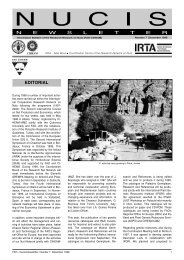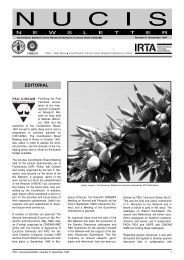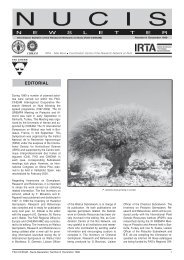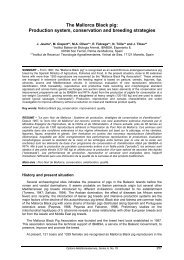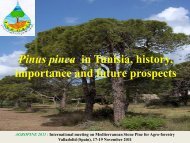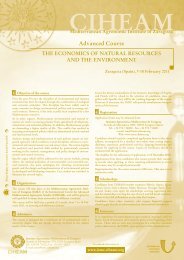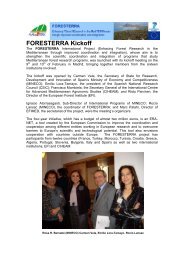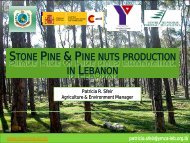NUCIS number 12. September 2004. 52 pages (full ... - IAMZ - ciheam
NUCIS number 12. September 2004. 52 pages (full ... - IAMZ - ciheam
NUCIS number 12. September 2004. 52 pages (full ... - IAMZ - ciheam
- No tags were found...
You also want an ePaper? Increase the reach of your titles
YUMPU automatically turns print PDFs into web optimized ePapers that Google loves.
season cultural practices may affect phenologyof female flowers, especially thetime of bud bloom, this model can also beuseful for reliable cultural programming.Picture 1. Healthy control (left) and necrotic bud (right), Immediately before bloomY. GholipourIranian Pistachio Research institute (IPRI)Qazvin Pistachio Research StationE-mail: ygholipour_trade@yahoo.comPicture 2. Control (left) and injured necrotic stigma and style (right)UNDERGROUND DRIP SYSTEM:THE NEW IRRIGATIONMETHOD FOR PISTACHIOAND ALMOND ORCHARDIN TURKEYPicture 3. Complete flower necrosis (left) and current shoot and inflorescence die back (right)cences), inflorescence, pistil, style, andstigma necrosis and deterioration, respectively.Injury level analysisFlower buds: their chilling resistance isthe highest among all reproductive structuresand organs. Their resistance, however,decreases as they finish their dormancyperiod, especially before bloom.Light injury (low to about -4 o C for about2h) could lead to their delayed bloom withsome blooming and flowering abnormalities.Deeper injury (about -4 to -6 o C forabout 6-8h) resulted in the necrosis anddeterioration of very young pistils in closedbuds (Picture 1).Inflorescences: in the first visible injury level,the tip vegetative growth (on the inflorescenceshoot) became darker green incolor. In this stage, the fertilization rateand subsequent fruit set can decrease,possibly because of negative effect of thelow temperature on the pollen tube growthand shortening physiologically effectiveage of the pistil. With more temperaturereduction (low to about -2 o C for about 2h),stigma, and then style showed morphologicalnecrosis and anatomical deterioration,which resulted in pollen germinationand tube growth inhibition (Picture 2).Complete necrosis of flowers, and then,inflorescence, caused by about -4 o C forabout 2h, was observed (Picture 3).Comparing this simulated pattern of injuryin laboratory, with injuries records fromorchards, showed that we can predict anddetermine injury level and subsequentevents in fruiting and abscissions basedon field temperature data. For example,due to temperature drop, down to 2 o C forabout 2 hours, it could be foreseen that adecrease in fruit set would happen as resultof delayed pollen tube growth,without visible symptoms. In some areas,lower temperatures caused visible injuriesof stigma, resulting in problemmes infertilization. We are developing a modelbased on environmental temperature(with other climatic parameters) data andfemales’ injuries, to make our cultivationsready for next years potencial spring chillingstress. By the way, since the earlyIt is well known that pistachio trees (Pistaciavera L.) are drought resistant. InTurkey the crop was not irrigated until recently.During the last decade seminarsand meetings on Pistachio productionand management were given by Prof.Kaska and Ak to farmers. They both triedto convince farmers to irrigate pistachiotrees, when water supply is available.Farmers believe that pistachio treesshould not be irrigated, because theywould die. This belief is only true when awrong irrigation method is applied.Commercial orchards are budded ontoPistacia vera rootstocks. This rootstock issusceptible to some diseases. We tellgrowers the usefulness of applying asound irrigation system. Some farmershave started to irrigate by tanker system.They have seen that irrigation is usefulfor pistachio trees. They recognized itseffects on reducing alternate bearing.When irrigating pistachio trees somechanges could occur as below: Treegrowth will be higher, leaf size will be bigger,the <strong>number</strong> of current year’s shootlength will be increased, yield will be increased,nut size will be higher, splittingpercentage will increase, blank nut ratewill be reduced, and less alternate bearing.24 FAO-CIHEAM - Nucis-Newsletter, Number 12 <strong>September</strong> 2004



